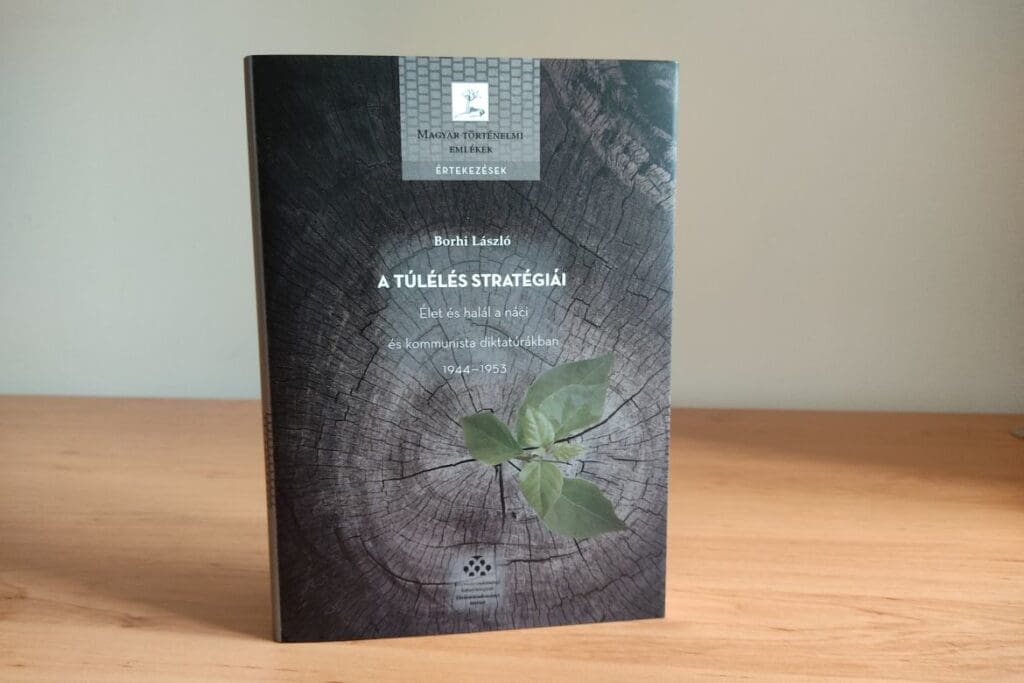The 2022 publication A túlélés stratégiái (The Strategies of Survival) is an easy-to-read, sophisticated and thoroughly researched book by Hungarian-American historian László Borhi on the relationship between the individual and state power during the terrors of Nazism and Stalinism. The work is not a comprehensive political history of the Holocaust or Stalinism. Rather, the book concentrates primarily on the experiences of ordinary people, with little attention to the experiences of state administration, civil and church leaders, or even members of the press.
In this sense, it takes the point of view of the ‘underdogs of history’, an approach that is quite refreshing.
The volume boldly asserts that the persecutions and the different forms of political violence under the Communist and Nazi dictatorships are comparable.
In this sense, it draws on the work of Hannah Arendt in a philosophical sense. and Rudolph Joseph Rummel in a historiographical sense, although it does not cite either author. The book as a whole is not otherwise characterized by political-ideological arguments, however, the lack of such arguments does not lessen the merits of the book. Borhi’s work is rich in data, with a sea of examples and quotations to support its position, and most of its references are primary sources, making it a very popular choice for those who like source-based works.
The structure of Borhi’s book is logical, with the first two parts of the book (120 and 100 pages, respectively) covering the history of Nazi and Arrow Cross atrocities, while the third (much shorter, 80 pages) gives a glimpse into the dark system of communism.
In terms of sources, the first two parts draw mainly on the testimonies of the DEGOB (Deportáltakat Gondozó Országos Bizottság, The National Committee for Attending Deportees), which are anonymized materials that can be read online. They have the advantage of having been recorded immediately after the war, providing a searchable, rich database for source material. However, they have the disadvantage of being shortened forms of testimonies that strongly reflect the biases of the people who wrote them down. The third part reconstructs the crimes of the Rákosi era, the domestic version of Stalinism, mainly from state security files and criminal trials. Sources from the 1960s tend to dominate, and in this sense, the volume is also a reflection of the Kádár era.
This neglect of the records of the People’s Courts may be explained by the often amateurish and problematic way in which these trials were conducted,
which leads some researchers to avoid using these sources altogether. The book does not attempt to exonerate the guilty, but its approach is empathetic and open to complex historical realities.
In recent years, increasing attention has been focused on the role of Hungarian civil servants during the deportations, or the complex state of affairs of the Jewish councils or the capos. In this light, the author’s comments are welcome:
‘Historical literature, using the language of law, usually uses the concepts of resistance and collaboration to depict the behaviour of the common man under totalitarian dictatorships or foreign occupation. This approach, however, raises a number of problems and does not take into account the grey zone that exists between the two.’ (Page 8 of the book).
Borhi, citing examples from foreign literature, notes that people were rarely confronted with ‘crystal clear images’ of resistance or collaboration. Survival dictated a search for modus vivendi, adaptation, and ways of co-existence. It is obviously more fruitful to look at the issues discussed in this book through such an approach than through the lens of dogmatic, black-and-white ‘condemnation’ or ‘absolution’.
The author bravely confronts controversial questions such as how to judge the role of a capo in the camps who tortures his fellow prisoners on orders from above.
‘What better explains the atrocities committed: coercion or the individual’s capacity or inclination for cruelty? Perhaps both, but to varying proportions.’ (17). The author points out that, in his research, it was not always possible to draw a clear line between the different roles. ‘Some played more than one role’ (20). ‘Several were convicted of collaborating with the Nazis and collaborating in atrocities, while other witnesses claimed that the person in question saved their lives’ (150).
The dilemma ultimately is: ‘Could one remain decent in such bloody anarchy?’ (150)
The author here, in my opinion, is exploring the most important and central questions in Holocaust research, and his volume shows through numerous examples how many different explanations are possible, how complex each individual case must have been, and how difficult—perhaps wrong?—it is to judge from the convenience of posterity the little people who faced so terrible choices.
An important observation regarding the dynamics of terror is that, in the case of Budapest, ‘a few hundred committed National Socialist and opportunist gunmen were able to intimidate a city of a million inhabitants’ (21). This is an important statement, as it may answer the charge that, because there were ‘few’ German occupiers in Hungary, the population could not have been seriously intimidated. Looking at foreign examples, it is a fact that in Amsterdam, too, a group of 25 collaborator detectives formed the core of the terrorists: a few dozen men with machine guns were enough to keep the tied-up authorities and civilians in check, Borhi’s research confirms.

What justified the terrorists’ astonishing brutality? In essence, the author rejects the brutalization thesis: ‘None of the Arrow Cross fighters whose accounts I have read returned from the Eastern Front, so they were not affected by the barbarity of war’ (22). Meanwhile, one may wonder whether the experience of the front was necessary for brutalization; and whether the bombings, or the sight of destruction and dead bodies was not enough.
The author presents a number of possible explanations (e.g. ideology, material gain, 38–49), but ultimately comes to the conclusion, shared by other authors such as Abram de Swaan, that
‘the sadistic murderer has no particular characteristic’ (23).
As a passing comment, one may note that some of the findings in the criminological literature on mass murderers and serial killers may help clarify this in the future. In any case, it must be noted that such a comparison of the Arrow Cross terror and the communist terror has been long needed, and, in this sense, the book is certainly unique and innovative. Scholars and history lovers alike will find many interesting things in Borhi’s book, which is a recommended read for everyone interested in 20th-century Hungarian history.
Related articles:







